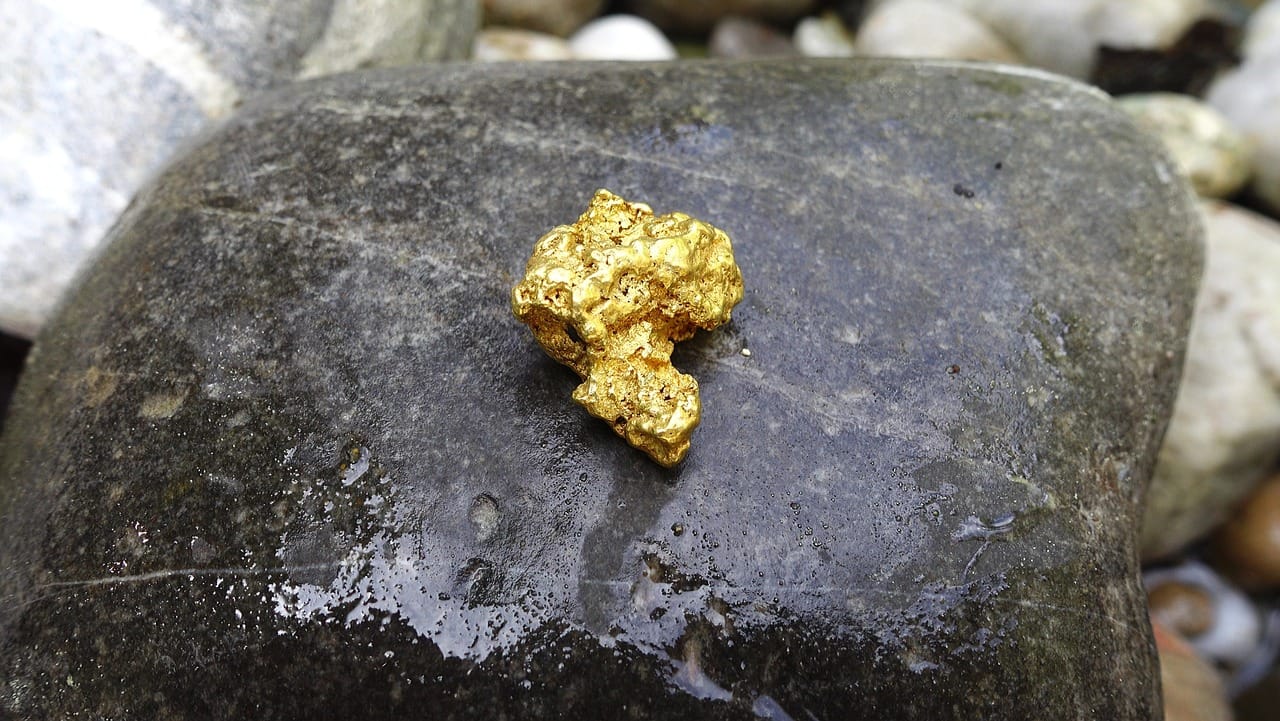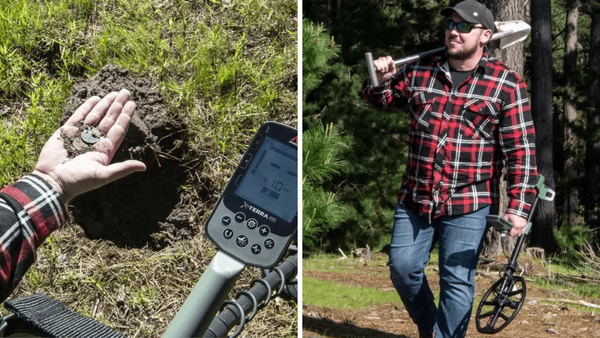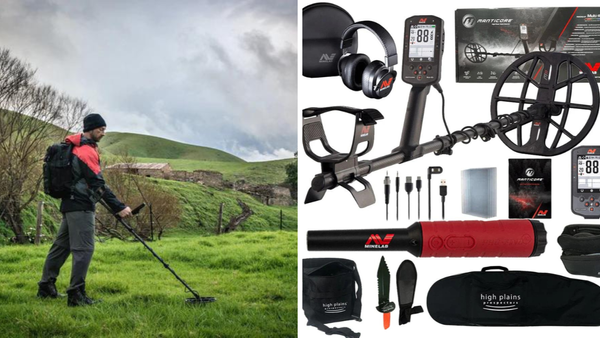Key Takeaways:
- Understanding the geology of dry river beds can lead to successful gold prospecting.
- Proper use of tools like gold pans, sluice boxes, and metal detectors increases the chances of finding gold.
- Patience and persistence are essential, as gold prospecting can be time-consuming but rewarding.
Gold prospecting is an adventure that can pay off with shiny rewards. For those with a keen eye and a bit of knowledge, dry river beds can be lucrative locations for finding gold.
This comprehensive guide will walk you through the steps and strategies for how to find gold in a dry river bed, ensuring you're equipped with the know-how to strike it rich.
The Geology of Gold in Dry River Beds
Dry river beds, or dry washes, are prime spots for gold miners. Over time, running water carries gold particles from their source, often depositing them in rivers and streams.
When these waterways dry up, they can leave behind placer deposits rich in gold. Understanding the geology of these areas is crucial for any prospector. Look for signs of past water flow, such as river channels and natural gold traps, where gold is likely to accumulate.
A Gold Pan And Other Tools of the Trade: What You'll Need
Before heading out to a dry creek bed, make sure you're well-equipped. A basic gold pan is essential for separating gold from other materials. For more efficient prospecting, a sluice box can help you process larger quantities of sediment.
Metal detectors specifically designed for gold can also be incredibly useful, especially for finding larger nuggets. Don't forget to bring along a sturdy shovel and a set of sieves for sorting through gravel deposits.
Reading the River: Identifying Gold-Bearing Areas
To find placer gold, you must learn to read the river. Even when dry, the bedrock outcroppings, large boulders, and gravel deposits can tell you where gold might be hiding.
Gold is heavy and will often settle in areas where the water slows down, such as inside bends or behind large rocks. These natural gold traps can hold rich pockets of placer gold.

The Role of Black Sand in Gold Prospecting
Black sand is a good indicator of potential gold. Composed of other minerals like magnetite, black sand is heavier than most other materials and tends to settle in the same way as gold.
When you find concentrations of black sand in a dry river bed, it's a sign that gold may not be far away. Use your gold pan to separate gold from black sand and other lighter materials.
Digging Deeper: Exposed Bedrock and Cracks
Exposed bedrock in a dry river bed can be a gold prospector's best friend. Gold particles often get trapped in small cracks and crevices in the bedrock.
Use a metal detector to scan the bedrock, and don't hesitate to dig into these cracks. Sometimes, the biggest gold nuggets are found hidden deep in these natural hiding spots.
The Importance of Test Holes In Finding Gold
Prospecting is a systematic process, and digging test holes can be an effective strategy. By digging several holes at different locations along the dry river bed, you can get a better idea of where gold is most concentrated.
This method can be time-consuming, but it's a crucial step in finding the most productive spots for gold panning or sluicing.
Flash Floods and Their Impact on Gold Distribution
Flash floods can dramatically change the landscape of dry river beds and redistribute gold. After significant rainfall, it's worth revisiting previously unproductive areas, as flash floods can uncover new gold deposits or concentrate existing ones in different locations.
Keep an eye on weather patterns and be prepared to act when conditions are right.

The Mysteries of Old Mines and Their Connection to Placer Gold Deposits
Have you ever wondered about the tales of old mines and their hidden treasures? Well, it turns out that these abandoned sites can be a hotbed for placer gold deposits.
As streams and creeks erode the landscape over time, they can unearth the riches from these old mines, dispersing fine gold throughout the river gold system. Prospectors often seek out these historical sites, knowing that the surrounding alluvial deposits may hold the key to their fortune.
It's like following the breadcrumbs left behind by miners of yesteryear, leading you to areas where big gold might just be waiting.
But here's the catch: locating real gold near old mines isn't just about luck; it's about understanding the geology and the history of mining in the area. The rusty reddish-brown tailings found near old mines can be a signpost pointing you towards gold-bearing material.
These areas, often overlooked, can be rich in fine gold that has been slowly grinding out of the mine's veins by natural processes.
So next time you're near an old mine, take a closer look. It might just change the direction of your prospecting journey, leading you to that elusive big gold.
Uncovering the Rusty Reddish Brown Indicators
Have you ever noticed the rusty reddish brown coloration in a dry river bed? This can be a telltale sign that you're on the right track to finding gold.
Iron-stained rocks are often associated with gold-bearing areas because both minerals are typically found in the same environments.
As you scan the river bed, keep an eye out for these oxidized rocks; they could be guiding you to your next big find.
But why exactly does this coloration occur? Well, when iron minerals come into contact with water and oxygen, they undergo a chemical reaction that results in rust. This process, known as oxidation, leaves behind the distinctive rusty reddish brown stains on rocks.
So, when you're out prospecting, consider these marks as arrows pointing towards potential gold traps. It's not a guarantee, but it's certainly a clue worth following.
The Dynamics of Dry Wash Prospecting
Prospecting in a dry wash can be a bit like trying to solve a mystery. As water flows through these areas during flash floods, it can change direction, creating various natural gold traps.
These traps are areas where the heavy gold particles settle because of a sudden decrease in water velocity. As a prospector, understanding how water moves through a dry wash is crucial to pinpointing where gold might accumulate.
Dry wash prospecting is indeed time-consuming, but it's also incredibly rewarding when done correctly. To master this technique, you need to study the layout of the land and identify where the water used to flow.
Look for bends in the dry wash, as these are prime spots for gold to settle. Remember, the goal is to think like water and anticipate where it might have left behind those precious flakes or nuggets. With patience and a keen eye, you'll increase your chances of striking gold.

The Secret Life of River Bends: Gold's Natural Hideout
Ever noticed how rivers tend to meander and create bends? These inside bends are more than just a scenic twist in the river channel; they are natural gold traps. As the current slows on the inside bend, the heavier material, including gold, settles out of the water column.
Over time, these areas can accumulate significant amounts of placer gold deposits. The key is to look for places where the river or stream has changed direction, creating an area where the water takes the shortest route, leaving behind the heavier gold on the longer, slower path.
But don't just look at the surface; the real gold might be hidden just beneath. When prospecting in these areas, it's essential to dig down to the bedrock, as gold tends to sink to the lowest point.
The bedrock can act as a natural shelf, catching and holding the fine gold as lighter material is washed away. This is where patience becomes a virtue, as the process can be time-consuming.
However, for those willing to put in the effort, the rewards can be substantial. Remember, the inside bend might just be the treasure chest in the winding river of gold prospecting.
Desert Prospecting: Special Considerations
Prospecting in desert areas, where many dry river beds are found, presents unique challenges. The summer months can be extremely hot, and water sources are scarce.
Always bring plenty of water, wear sun protection, and be aware of the local wildlife. Desert prospecting can be tough, but the potential for finding gold in these areas is often higher due to less competition and untouched deposits.
The Allure of Quartz Veins
Quartz veins are often associated with gold deposits. As you explore dry river beds, keep an eye out for these veins, especially where they intersect with bedrock outcroppings.
Gold can be found in and around these veins, so they're always worth investigating with your metal detector and other prospecting tools.
Sifting Through Gravel Deposits
Gravel deposits in a dry river bed can be a treasure trove for gold prospectors. These deposits are the result of years of water flowing over rocks, breaking them down and sorting them by size and weight.
Gold, being heavy, will often be found at the bottom of these deposits. Use your sluice box to process large quantities of gravel and maximize your chances of finding gold.
The Role of Large Boulders in Gold Prospecting
Large boulders can act as natural riffles, catching gold as water flows around them. When prospecting in a dry river bed, examine the downstream side of large boulders.
Dig and pan the sediment that has accumulated there, as it's likely to contain gold particles or even larger nuggets.

Understanding Placer Deposits
Placer deposits are concentrations of gold that have been naturally sorted and deposited by water action.
Recognizing the characteristics of placer deposits, such as their location in relation to the old streambed and the presence of rounded rocks, can guide you to more gold. Study the geology of the area and look for signs that indicate the presence of placer gold.
The Science of Separating Gold
Separating gold from other materials in a dry river bed is a science in itself. Gold panning is the most traditional method, relying on the gold's density to sink to the bottom of the pan.
For finer gold, a sluice box can help separate gold particles more efficiently, using water flow and gravity to your advantage.
Maximizing Your Find: Tips and Tricks
To maximize your chances of finding gold, be persistent and thorough. Many prospectors give up too soon or don't explore an area fully.
Dig multiple test holes, recheck areas after flash floods, and don't be afraid to go off the beaten path. Sometimes, the most unlikely spots can yield the biggest rewards.
Safety and Environmental Considerations
Safety should always be your top priority. Be aware of the potential for flash floods, especially in desert areas, and never prospect alone. Additionally, respect the environment by filling in any holes you dig and disposing of any waste properly. Responsible prospecting ensures that the adventure can be enjoyed by future generations.
Some Final Thoughts
Finding gold in a dry river bed is a combination of knowledge, patience, and the right tools.
By understanding the geology of dry river beds, using tools like gold pans and sluice boxes effectively, and knowing where to look for natural gold traps, you can increase your chances of striking it rich.
Remember to be persistent, dig test holes, and keep an eye out for environmental changes that could reveal new gold deposits. With these tips and strategies, you're well on your way to becoming a successful gold prospector.

FAQ's
Is it legal to prospect for gold in any dry river bed?
Not always. You must check local laws and regulations regarding mineral rights and land access. Some areas may require permits or be protected, prohibiting prospecting activities.
How do I know if a dry river bed has gold?
Look for signs of past water flow, such as natural gold traps, black sand, and placer deposits. Using a metal detector can also help you identify gold-bearing areas.
Can I find gold in a dry river bed without water?
Yes, you can find gold in a dry river bed without water. Tools like metal detectors and dry panning techniques can be used to locate gold deposits in these environments.













Member discussion